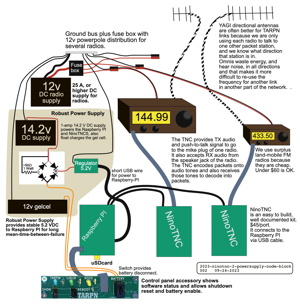FAQ: Node/Switch Diagram and brief description
Every station in a Terrestrial Amateur Radio Packet Network consists of a Raspberry PI, a
TNC, a radio, and an antenna.
The Raspberry PI TARPN architecture is
expandable.
You can start with one TNC, radio and antenna, and add more later if the need arises.
The drawing below represents a 3 port node, with 3 sets of TNC + radio + feedline + antenna.
A TARPN node could be built from a variety of radios and TNCs, though the Raspberry PI is a required component.
The TNC element needs to be a KISS TNC capable of talking to one other neighbor, who must have a TNC of matching capability tolking to just your station.
NinoTNC is available for $45 each.
Your link could be using a pair of KPC-3 or other model.
It is very handy if both ends of the link are using the same TNC, but it isn't critical.
The Raspberry PI and memory card cost about $45 from Amazon or other vendors.
The radios are usually old ham monoband mobiles or surplus commercial radios.
TARPN participants can help you find and configure 25watt 6m, 2m, 70cm commercial land-mobile transceivers for your TARPN project, at under $60 each.
See
Node Shopping List.
Why multiple radios? Why multiple bands?
Each station can have one or more links, with one link per neighbor.
TARPN nodes use dedicated point to point links to neighbors to overcome congestion and collision problems.
See Networking on Purpose for the why of dedicated links.
Each link runs asynchronous to each other link and so you could have inbound traffic on one link while transmitting a message on another.
While it is possible to receive on a radio while transmitting on another on the same band without blocking the receiving radio, it is much easier to do that when on different bands.
It may seem difficult or complex to do multiple bands.
However, it is easier to do multiple bands than to do two radios on the same band.
Here is a block diagram for a typical TARPN node design.
Click to see supplemental detail and larger images.

The images appear to specify that we
must use NinoTNC to build a TARPN node.
We designed
NinoTNC ourselves to be the most versatile and inexpensive KISS TNC.
It's also cheap.
There are other solutions and the Raspberry PI with G8BPQ's linbpq program is very versatile.
You could build a node which uses radio with built-in TNC, or uses TNCs which are stand-alone units using USB to talk to the PI, and the radios could be handie-talkies.
The antennas shown include a separate antenna for each radio.
You could use a multi-band vertical.
Some stations are close enough together that very trivial indoor antennas will perform.
However, the hardest part of building a TARPN, so far, has been distance and antennas.
The only required part of the node is that it uses a Raspberry PI.
We actually have a well described and specific set of rules for participation. (see Rules for TARPNS)
Everything else is dependent on the situation the node/switch is being built for.
Please visit our FAQS page for more background info.
If you can't find what you are looking for, we may not have thought of the question you are asking.
I would really appreciate an email advising me of the mistake.
I'll pass it around to the appropriate party and find out an answer.
Send me an email at the address shown on my QRZ.com page.
When I get an answer I'll either pass it on to you, or publish it on the web page and tell you about it.
Thanks.
See also
TARPN features and
Networking On Purpose
